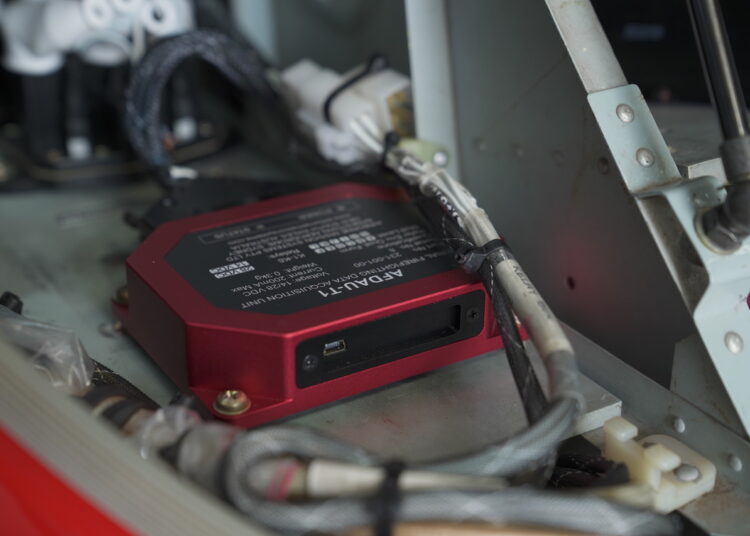The AFDAU-T1, Australia’s standout additional telemetry unit (ATU) for aerial firefighting, has achieved compliance for the new US Forest Service requirements for event data this week. The update enables all Aerial Firefighting Data Acquisition Unit (AFDAU) units already installed in aircraft to meet compliance specifications
AFDAU-T1 lead engineer, Zane Vohland, says that with the increase in demand for real-time telemetry in contracts issued by aerial firefighting agencies, the AFDAU-T1’s new compliance is a huge win for operators in the United States.
“It’s clear that ATU requirements are becoming more prevalent in US aerial firefighting contracts. As these requirements make their way from VLATs and type 1 helicopters into smaller aircraft, we are seeing orders from operators who are looking for a turnkey solution that enables them to stay compliant.”
Zane adds that when investing in ATU equipment, operators can find themselves comparing apples to oranges and need to ensure the equipment they are considering provides a full solution.
“Some signs of an incomplete solution include extensive calibration of the ATU device required for volume detection, lack of clear and comprehensive documentation on how to interface with the various sensors required, lack of validated end-to-end data pipeline from hardware to agency portal, and a lack of proven results, including accurate volume reporting, for the applicable airframe and sensor configuration.
In addition to this Zane says that despite years of development, many ATU devices still face the same issues of how a device detects and records particular events.
“Due to the dynamic nature of firefighting operations, it’s not unusual to see errors in the types of event data coming off ATUs. These typically occur on take-off and landing events, engine on and off events, and inaccurate recordings for fill, drop, and volume events.
“The AFDAU-T1 however leverages a proprietary ‘smart algorithm’ to detect aerial firefighting events with unparalleled fidelity. Through extensive R&D and close partnerships with some of Australia’s key fixed-wing and helicopter firefighting operators, we have developed a large and comprehensive dataset of aerial firefighting operations and expanded our expertise in the field, to deliver, in the AFDAU-T1,” says Zane.
In addition to the US Forest Service compliance, Airborne Mission Systems, the makers of the AFDAU, has also developed a diagnostic tool which allows avionics engineers to quickly identify and rectify any communication issues (wiring, connections etc) between another device and the AFDAU at the point of install. This has the potential to save thousands of dollars of time both on the ground and in the air trying to troubleshoot installation issues.
The AFDAU is available worldwide exclusively via leading aerial firefighting tracking and communications company TracPlus.
About TracPlus
As the trusted provider of the mission-critical tracking and communications platform of first responders, government agencies, militaries, and other critical operators around the world, TracPlus has been present at virtually every major disaster response globally in the past five years.
We tie multiple data streams and asset types into a single view of the truth for mission-critical operations and deliver situational awareness to operators, irrespective of who owns the asset, what the asset is, who provides the tracking, or what the platform or signal type is — be it radio, cellular or satellite.
Our powerful, cloud-based platform allows organizations to track, manage, monitor, and message their personnel and resources, including land, maritime, and aviation assets, to keep crews safe, conserve resources, and maximize coordinated efforts.
TracPlus is the only commercial provider to deliver a whole-of-country solution for integrated aircraft tracking in the wildfire management space.
TracPlus has its roots in search and rescue after a boating triple-fatality in 2003 off the coast of New Zealand's South Island. The vessel had a traditional 121MHz-style rescue beacon which provided a basic locational signal but due to the requirement of multiple satellite passes to pinpoint the rescue location it meant that four possible locations for the party were identified on different sides of the country.
It wasn't until almost three hours after the initial incident occurred that the rescue team were able to find the vessel by which time three of the six occupants had succumbed to the treacherous conditions. Following this incident, the pilot of the rescue helicopter and a local technology enthusiast got together to come up with a better way to find people in distress; by actively tracking them all the time, not just when they need help. In late 2005, a small satellite-based tracking terminal was fitted to a helicopter, and 18-months later, TracPlus was born. Since then we've earned the trust of over 1000 customers in 46 countries, operating 8,500,000 operational hours, and have been on board at most of the world's largest emergency responses.






